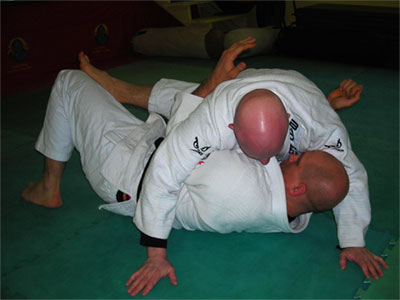We recently talked about some examples of good defensive posture when you’re on the bottom, achieving good posture when pinned under your opponent is the first, and often the most critical, step in the escape process. Today we’ll address how to achieve good posture on the bottom while your opponent is doing everything he can to prevent it.
Most of the time when I am on the bottom I use one of two strategies to get into proper posture:
1 – Use your bridge. The bridge is an important escape motion, but it is also a useful tool to create space, allowing you to move your hands, forearms and elbows into position.
For one example of this concept, let’s say that you are trying to get to the following position (more more fully described in this tip):
 To do this posture correctly you have to get your left hand under your opponent’s armpit by sneaking your hand between your chest and your opponent’s chest. Too much friction and too little room can make this a difficult task.
To do this posture correctly you have to get your left hand under your opponent’s armpit by sneaking your hand between your chest and your opponent’s chest. Too much friction and too little room can make this a difficult task.
One solution to get your hand in there is to do a series of short little bridges, one right after the other: every time you bounce your opponent his chest pressure lessens momentarily, and that means you can sneak your hand a little bit closer to its goal.
Of course you should save some energy, because as soon as you get to your posture you need to do a big bridge to throw your opponent up and come out the back door!
2 – Posturing during the pass. In every successful guard pass there comes a point when the person on bottom realizes that getting pinned is inevitable. THIS is when the bottom person should start fighting for posture, NOT once the guard pass is finalized and his opponent’s position is stabilized. It is much easier to establish posture in the final few moments of the guard pass than it is to fight to get your limbs into position under a tight side control.
It takes beginners a while to grasp this concept because they don’t know how to posture, and also because they have difficulty recognizing the point of no return in a guard pass. The solution to this problem is time on the mats.
Intermediate-level grapplers – roughly blue belt level in BJJ terminology – sometimes also have problems grasping this concept, but for different reasons. These grapplers have learned many things since they were beginners, including:
- how to prevent common guard passes, and
- how to relax while pinned on the bottom.
However in this case, 1 plus 2 equals premature relaxation; they settle into ‘being pinned mode’ a second or two too early, instead of fighting to establish posture in the final stages of the guard pass.
If you are grappling someone who relaxes prematurely it goes something like this: you battle to get your grips and establish posture, you finally figure out a way to uncross their ankles, you control the legs and hips with difficulty, you force the guard pass as they try to wriggle out of it, and then, all of a sudden, they just give up and lie on the mat like a starfish.
The solution lies in their training partners recognizing the problem, printing out this tip and giving it to them.
Set your escapes up early by fighting for posture before your opponent has stabilized his position: you won’t be sorry you did. If you are already pinned then try to imagine yourself as a ratchet: every time your create space, or are given space by your opponent, your limbs move into better posture and never give up the ground you’ve gained.
The post How To Get Posture While Pinned appeared first on Grapplearts.
